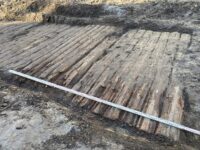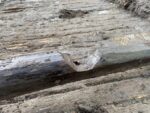 Archaeologists have discovered a well-preserved stretch of a late 17th or early 18th century wooden road in Jarosław, southeastern Poland. At 100 feet long, it is one of the longest wooden roads ever discovered in what is now Poland.
Archaeologists have discovered a well-preserved stretch of a late 17th or early 18th century wooden road in Jarosław, southeastern Poland. At 100 feet long, it is one of the longest wooden roads ever discovered in what is now Poland.
The remains were discovered in February during an archaeological exploration of the site of planned sewer work in the historic center of the city. The road led to a gate in the city walls opening west towards Kraków. It was part of a 250-mile route connecting Bielsko Biała to Lviv in modern-day Ukraine. It was a dirt road, except for the section inside Jarosław.
 The road was 10 feet wide, so must have been one-way traffic only because that was not enough space for two lanes. It was made of timbers mounted on transverse wooden joists. The wood was probably oak and it was very sturdy. There are no hoof marks or wheel ruts even though it must have been a busy street as Jarosław held one of the largest market fairs in Europe and was a major hub of trade in the region. It was in active use for about 100 years before paved roads were built over it.
The road was 10 feet wide, so must have been one-way traffic only because that was not enough space for two lanes. It was made of timbers mounted on transverse wooden joists. The wood was probably oak and it was very sturdy. There are no hoof marks or wheel ruts even though it must have been a busy street as Jarosław held one of the largest market fairs in Europe and was a major hub of trade in the region. It was in active use for about 100 years before paved roads were built over it.
 Some of the road has been removed to the Jarosław Museum for conservation and study. Objects found during the removal of the timbers — coins, show leather, nails — will go on display in the museum. The section still in place will be displayed in situ in the coming months.
Some of the road has been removed to the Jarosław Museum for conservation and study. Objects found during the removal of the timbers — coins, show leather, nails — will go on display in the museum. The section still in place will be displayed in situ in the coming months.
The road was laser scanned before removal so a detailed animated model could be made accurate to the millimeter.
Wood that well-preserved would be easily-identified if it is oak, by the presence of the radial cell-structures, which would be the last to go.
Similar “timber trackways” have particularly in northern Europe a rather long tradition.
After in 9AD three Roman legions, namely Legio 17, 18 and 19, had been annihilated, the Battle at the “Long Bridges” (‘Pontes Longi’) was fought in 15 AD between troops under general Caecina and an alliance commanded by ‘Arminius’, i.e. as part of a three-year series of campaigns by Germanicus:
en.wikipedia.org/wiki/Aulus_Caecina_Severus_(consul_1_BC)
en.wikisource.org/wiki/The_Annals_(Tacitus)/Book_1#62
Germanicus and Caecina advanced to the old site of the Varus Battle and buried the remains of the dead. The Battle at the “Long Bridges”, according to Tacitus, ended in a draw. However, the assumption is that the Romans suffered losses and particularly their cavalry and auxiliary troops seem to have been battered. Germanicus, however, immediately withdrew, although he had apparently planned to keep the area occupied.
Germanicus, who was west of the Weser at this time, first retreated to the river Ems (“Amisia”) and then led four legions back to the Lower Rhine. These suffered losses due to a storm tide. Before that he ordered Caecina with four legions –namely the 1st, the 5th, the 20th and the 21st, all in all 28,000 to 30,000 men including troops– to repair a causeway referred to as “pontes longi”, which had been (re?)built by the Romans around the year 1 AD.
This is often assumed to be a wooden plank path through the swampy Lippe lowlands between Xanten and Haltern or even Rheine, but that remains unproven. It has been pointed out that the conventional Germanic plank roads could not have been suitable to carry Roman legions, so it must have been an embanked road. Thus, Caecina was maybe not moving over a longer way on those “pontes longi”, but repaired an old Roman causeway elsewhere. (Bk1. 63–69)
en.wikisource.org/wiki/The_Annals_(Tacitus)/Book_1#63
Having nails, show leather, and especially coins be embedded inside the road showcases how even 300-plus years ago people were losing personal belongings. The lack of hoof marks and wheel ruts does pose questions about potentially unloading horse-drawn goods to be hand carried into market.